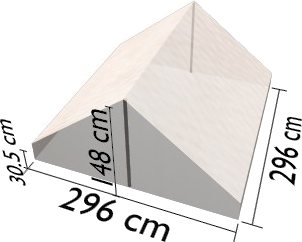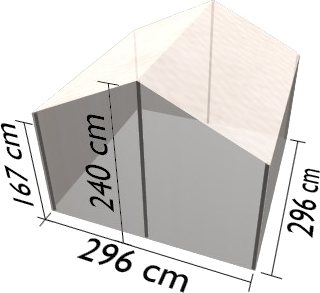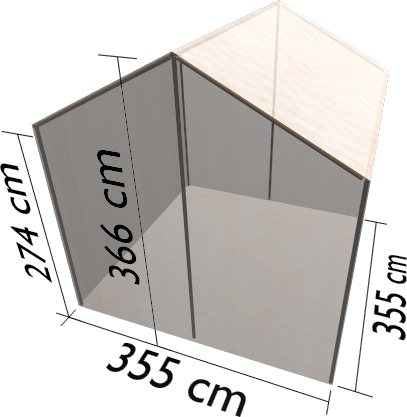Tents in Roman Camp
Some news about the three types of tents used in the Roman camp and their short description, the original and full version was available at the follow link (now it is broken!): Camps
The contubernium^
The 8 man tent group was called a contubernium. It seems to have formed a basic unit of the Roman army throughout its history. The most common depiction of the tent is shown below (without the guy ropes). The tent is 2.96 m square (10 Roman feet) and about 1.48 m tall (5 Roman feet).
Each contubernium is usually assigned a pack mule to carry the tent and other heavy gear, at least from the time of Marius on. A servant led the mule on the march and provided other services to the Contubernium. The mule carries the two tent poles, a folded tent, stakes, ropes, two baskets that will also be used in excavating the camp ditch, the digging tools, a small stone wheat grinder, and extra food.
In some camp layouts the tents are placed so closely together that the stakes would have to overlap. The stakes would present an obstacle to anyone trying to walk between the tents, especially at night. Some descriptions would have arms and armor stacked behind the tents. In case of a emergency the the soldiers would have to don their armor and then move between tents to assemble in front. The crossed guy ropes and stakes would seem to present a serious hazard at night in this instance.
Sleeping arrangements^
The 8 man tent is variously described as serving either 8 or 10 soldiers. Almost all descriptions state that 1/4 of the soldiers would have been on watch at any given time so that the tent would only have to sleep either 6 or 8 men. Some authors say that the legions, at least those after Marius' changes, had one mule assigned to each Contubernium to carry the tent and other heavy gear for the unit. In one version the servants are described as sharing the tent with the soldiers, increasing the number of occupants by one. In another, the servants the century are described as grouped together in a tent of their own. Most camp descriptions do not fully consider the question of servants' tents.
The sleeping capacity of the tent would be a maximum of 8, leaving very little room inside for the storage of clothing or other gear that needed to be kept out of the weather. Given these considerations, it seems less likely that a tent could serve 10 soldiers. 8 would fit comfortably, sleeping 6 plus a servant and still leaving some room for clothing and other gear.
 a contubernium example
a contubernium exampleThe officer's tent^
According to most sources the centurions each had their own tent. That shown here follows Connolly. Since the centurion also used his tent as an office the higher side walls would have given the needed head room. The tent shown here is also 2.96 m square (10 Roman feet) but occupies more space because of the longer guy ropes. There are also more tent poles -- two center poles and 4 corner poles .
The officer's tent is carried on a mule which has a servant assigned to it as well. Because of the larger size of the officer's tent there are more supporting poles. The mule would, presumably, have also carried food and other gear for the officer.
 a officer's tent example
a officer's tent exampleThe general's tent^
The general and, perhaps, other senior officers are shown with much larger tents. The tent shown here is 3.55 m square (12 Roman feet). The side walls are 2.74 m high (9'), the peak is 3.66 m high (12').
Note the length of the guy ropes (not present in the picture). Because of the size of the tent it would have been necessary to use a number of poles for its support. The poles could have been carried on two mules. A tent of this size may have been carried on a cart or wagon. But wagons pulled by oxen were slow and limited in where they could travel. The tent could have been loaded onto several mules.
 a general's tent example
a general's tent example
| Front and back | Sides | Top slopes | Total area | Weight in kg | Number of panels | Panels thickness | Pack thickness | |
| (m2) | (m2) | (m2) | (m2) | (kg) | (mm) | (mm) | ||
| General's tent | 10.89 | 9.43 | 6.89 | 54.42 | 51.4 | 98 | 116 | 349 |
| Officier's tent | 6.24 | 5 | 4.76 | 32 | 30.2 | 57 | 68 | 205 |
| Contubernium tent | 2.84 | 0.85 | 5.72 | 18.82 | 17.8 | 34 | 40 | 121 |
| each | each | each | ||||||
| This data is based on tents made of 85.05 g (3 oz.) leather, that is, it weighs 85.05 g (3 onces) per 0.09 m2 (square foot). The thickness of the leather is 1.27 mm (3/64''). The dimensions are taken directly from the drawings. To estimate the size of the pack, the tent is divided into 0.61 by 0.91 m panels (2' by 3'), roughly the size that could fit on a mule. When stacked it is assumed that the thickness will triple because of gaps between the layers, wrinkles, and the like. This is the "Pack tichkness". | ||||||||
Le fonti^
- Article by The Roman Army, Camps
- Illustrations, pagination and editing by Titus Cornelius
Changelog^
- (26/02/2004) First version
- (Summer 2005) revision and pagination for the web





